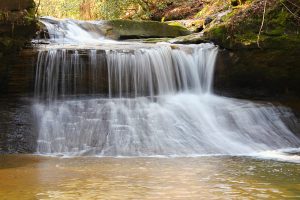Healing the Red River’s Tributaries

The Red River’s Wild & Scenic designation offers special protections to places like Creation Falls. Photo by Karen Roussel
By Dac Collins
The Red River in eastern Kentucky forms one of the most spectacular gorges in the country. Its sandstone arches, cliffs and unique rock formations lure climbers and fascinate geologists, and many of its rock shelters and caves are classified as significant archeological sites. A dam proposal in the late 1960s would have swallowed up the gorge, but Kentuckians, with help from the Sierra Club and writer-activist Wendell Berry, grappled with the U.S. Army Corps of Engineers until the Red was granted federal protection in 1993 under the Wild and Scenic Rivers Act.
The Wild and Scenic designation applies to the stretch of river that passes through the gorge, but it does not protect the entire Red River watershed from human impacts. That is why members of the Kentucky Waterways Alliance, an environmental nonprofit, collaborated with the state’s Division of Water and the U.S. Forest Service to create the Red River Gorge Restoration and Watershed Plan, which addresses potential threats to the water quality of four creeks that flow into the iconic river. These threats include high levels of sediment resulting from road construction, and contaminated runoff from residential areas.
Because portions of these tributaries are located on private property, the watershed plan recommends “best management practices” that property owners can implement in order to reduce the amount of polluted runoff. Maintaining a riparian buffer of streamside vegetation, which prevents bank erosion, is just one solution that private landowners can choose to implement.
Tessa Eedlen, watershed program director at the Kentucky Waterways Alliance, says, “We’re also going to be focusing on septic systems, [including] repair, pump outs and, if necessary, replacement.” According to Eedlen, this is a major issue along Swift Camp Creek, where many homeowners are using old or defective pipes that leak sewage into the stream.
The nonprofit organization has secured an implementation grant from the Kentucky Division of Water, which Eedlen hopes to use to create financial incentive programs for homeowners. The grant money will fund other stream restoration projects as well, such as the removal of two culverts on Indian Creek that are currently impeding the passage of fish.
The Kentucky Waterways Alliance will be hosting creek cleanups and streamside tree plantings this fall. Visit their website to get involved: kwalliance.org/red-river-watershed
Related Articles
Latest News

Leave a comment
Your email address will not be published. Required fields are marked *





Leave a Comment